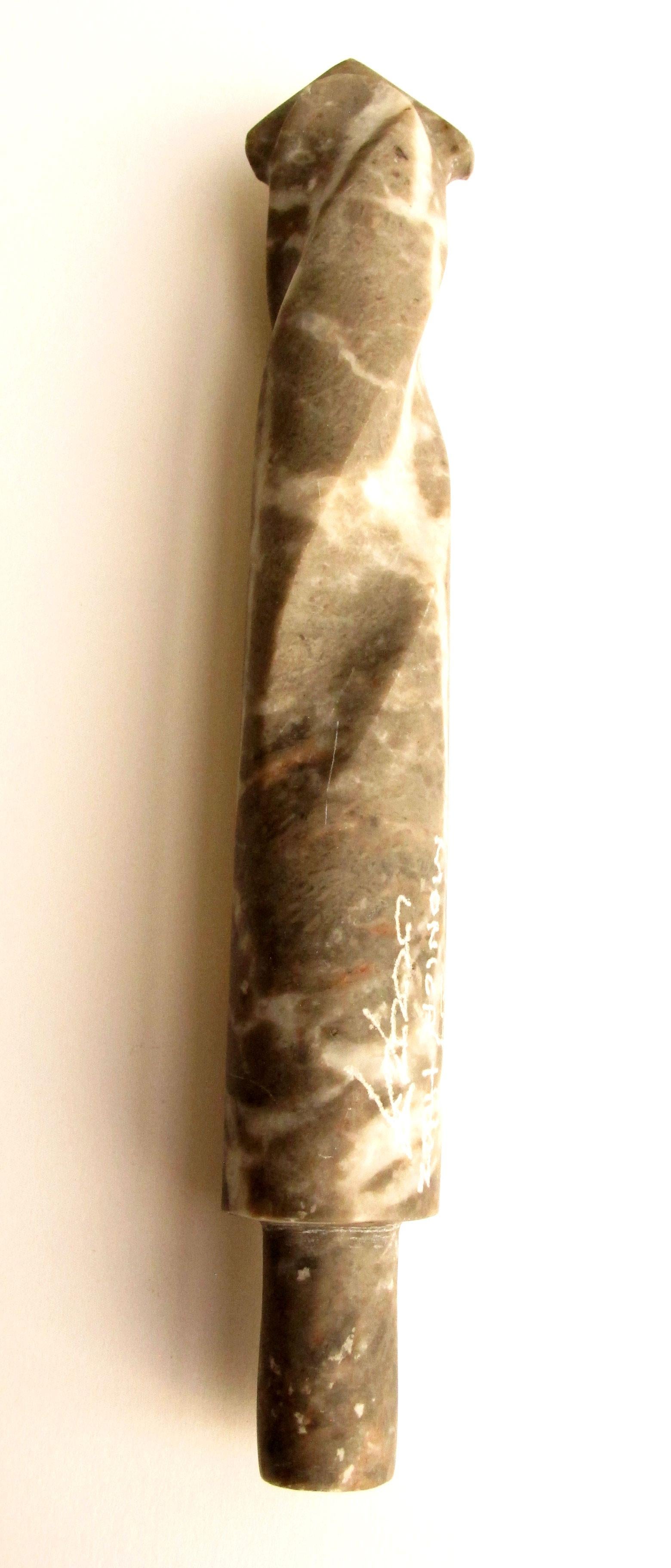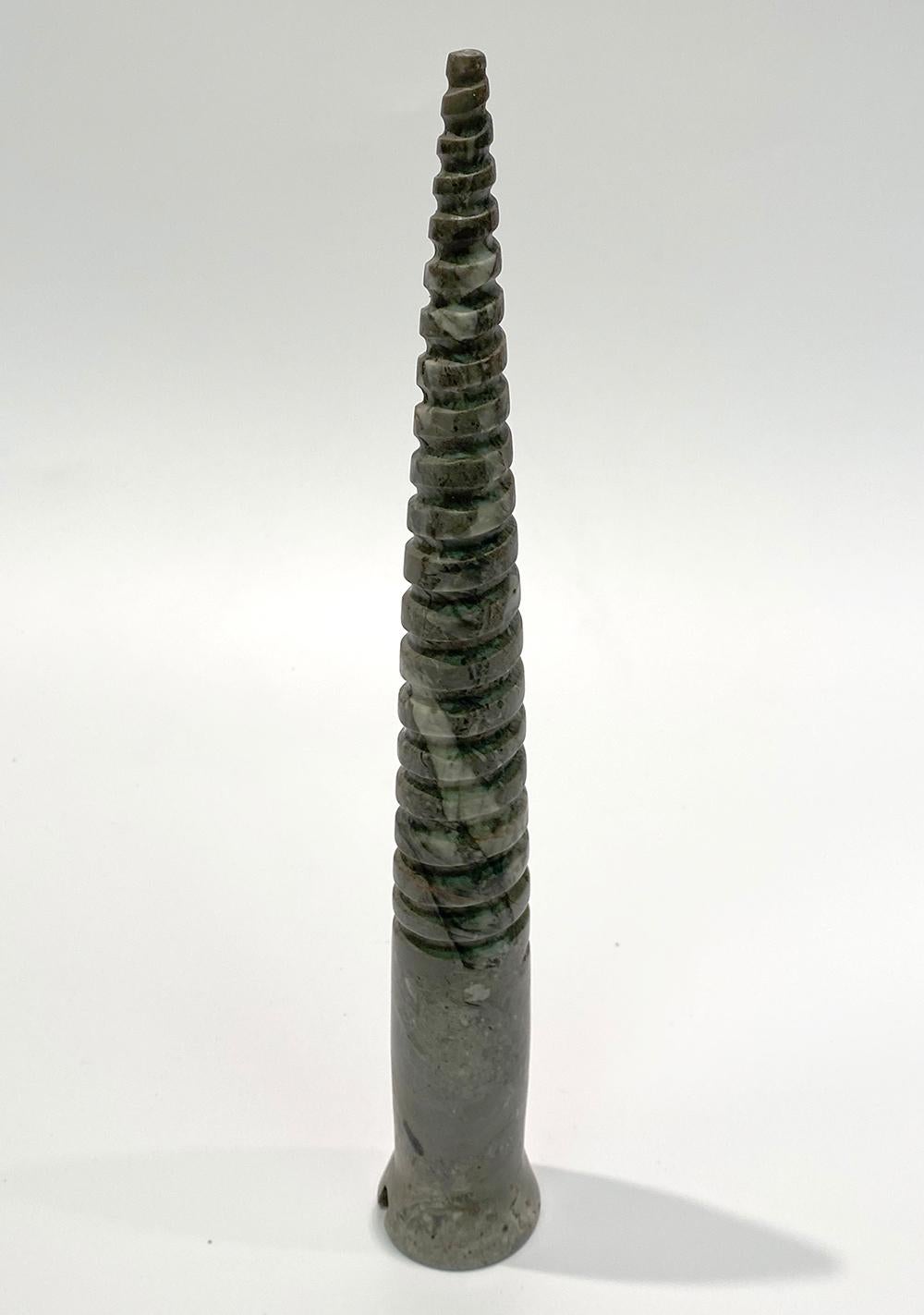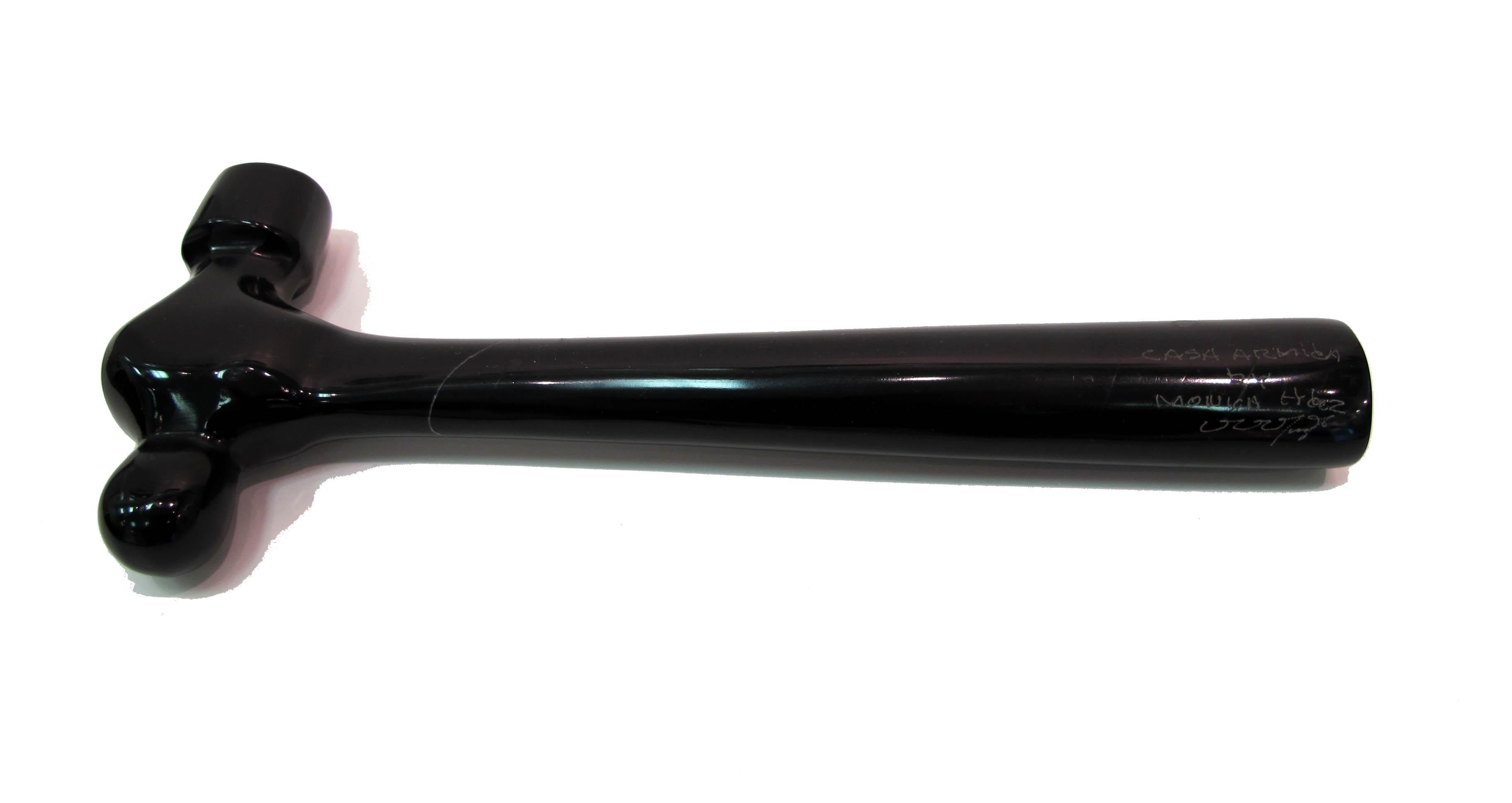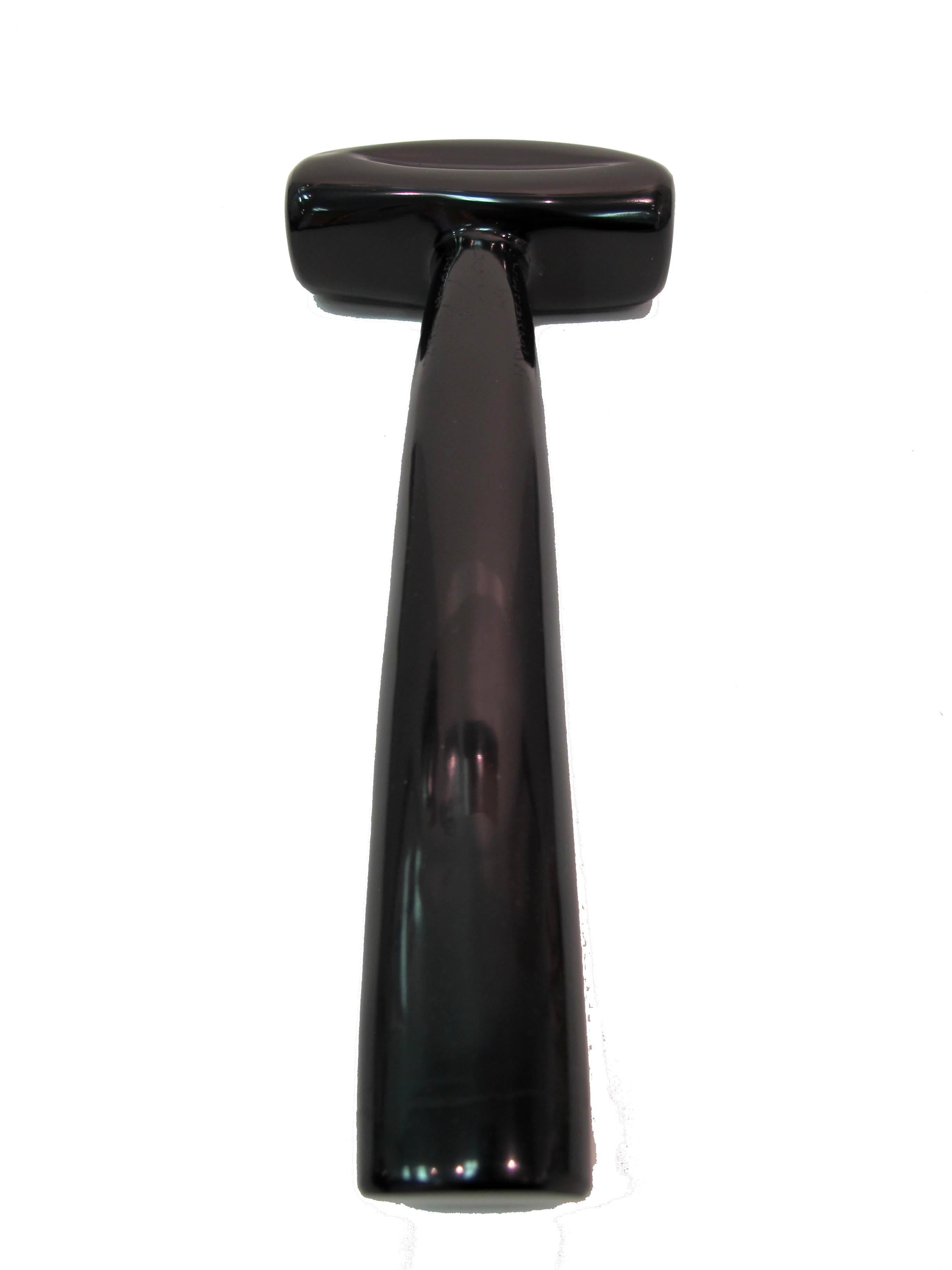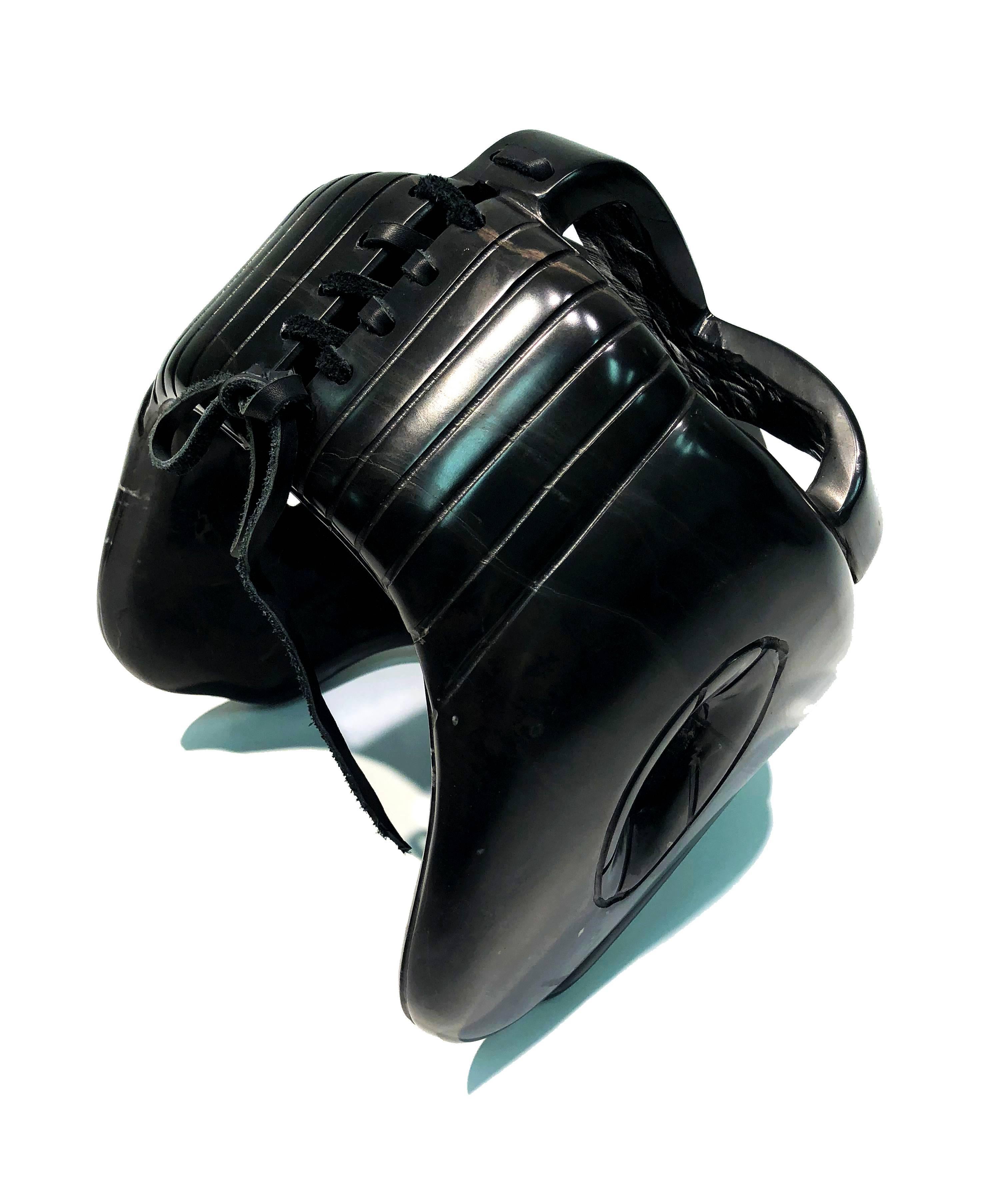Items Similar to Art Déco Period Large Carrara Marble Sculpture Bust.
Want more images or videos?
Request additional images or videos from the seller
1 of 21
Raymond DelamarreArt Déco Period Large Carrara Marble Sculpture Bust.1923
1923
About the Item
Art Déco period, large Carrara marble female bust sculpture by Raymond Delamarre, one of the pre eminent Art Deco sculptors of his day. Fashioned like a Renaissance Princess but with all the decorative details of the Art Deco period in the handling of the hair and dress. Having won the Prix de Rome in 1920, Delamarre sculpted his now famous 'Suzanne au bain'. Some of the details of this sculpture are very reminiscent of this work and it may have been sculpted during his period in Rome.
The sculpture when lit has a calm luminescence and beauty.
The sculpture entitled "Suzanne" was the first work sent to Paris by Delamarre from Rome. When the Villa Médicis reopened after the war their finances were in a poor state and in 1920 they were not able to organize the traditional exhibition, which showed works completed by students and deemed suitable to be sent to Paris. That academic year, Delamarre had prepared a female nude study in plaster but this was not shown until an exhibition was organized in Rome for the year 1921, by which time the Villa had started to get back to normal. It was then shown in Paris in the September of that year. In 1926 a Carrara marble version was accepted by the Petit Palais des Champs-Elysées. In 1960 it was moved to the Musée d’art moderne in Paris.
(The Delamarre family have recently reached out to us to confirm they held the original drawings and plaster model for this sculpture which they have donated to the museum 'La Piscine a Roubaix' where they are now on permanent display. They have confirmed the sitter was Marie-Rose de Sault, daughter of the politician Charles Jonnart and the work dates to 1923.)
Raymond Delamarre (1890–1986) was a French sculptor and medallist. He played a major role in the Art Déco movement. While his ecclesiastical work showed the influence of Catholicism, he was personally agnostic. His art, especially his war memorials, was also influenced by his firsthand experiences of the horrors of the First World War.
When aged sixteen years, Delamarre joined the École des Beaux-Arts in Paris and was attached to the studio of Jules-Félix Coutan. His studies were interrupted, firstly by his conscription into the army from 1911 to 1913 and then service from 1914 to 1918 after the French mobilization, although between the two he managed some further time back in Coutan's studio. Soon after mobilization Delamarre was sent to the front and was almost immediately taken prisoner. He was released in the course of an exchange of prisoners carried out in 1916 and returned to active service.
On leaving the army at the end of the war, Delamarre now tried to secure the "Prix de Rome" and with the bas-relief "Le retour du guerrier au foyer familial" he shared the prize with Alfred Janniot which meant he was able to spend four years in Rome at the Villa Médicis. He was to stay in Rome until 1924, grew a moustache and visited and studied the sculpture of Greece. The composition "Suzanne au bain" exhibited in 1921 at the Salon des Artistes Français is a good illustration of Delamarre's work at this time.
In 1925 and in collaboration with the architect Michel Roux Spitz, he took part in the competition to secure the work on the proposed "Monument à la Défense du canal de Suez" to be erected in Ismaîlia, a work of huge proportions and a most prestigious project. Also working with Roux-Spitz, he exhibited a sculptural composition for a water fountain at the Exposition des Arts Décoratifs in Paris, the bas-reliefs "Nessus et Dejanire" and "Persée et Andromède" cast in bronze in 1935, two tympani for the decorator Paul Follot, a bronze entitled "David" and a work in plaster entitled "Femme au bélier". Between 1926 and 1927, Delamarre worked on the "Mowgli" ronde-bosse. He also executed a bas-relief of Mowgli in plaster measuring 2 metres by 2 metres.
In 1927, Delamarre married Mariel Jean-Brunhes, the daughter of the geographer Jean Brunhes and they made visits to Spain and the Ballearics. In 1928, he produced the group "Adam et Eve" or "La tentation" in bronze, which composition was to appear subsequently in various limited editions, in both bronze and plaster. In 1931, he participated in the Exposition Coloniale de Paris, creating the figure of Christ carved from acajou wood from Cuba and eight Beatitudes. 1935 saw completion of his work for the ocean liner "Normandie" and 1937 he completed his great work in bronze for the Palais de Chaillot with three 4-metre-high figures being created symbolizing Philosophy, the Visual Arts and the Arts. These figures were erected after the 1939–40 war. These three figures were to reappear in a number of limited editions in both plaster and bronze and in a variety of sizes. From 1961 to 1973, he managed the business of the "Art Sacré" studios in Paris' place de Furstenberg, working with Maurice Denis and Georges Desvallières.
In 1963 Delamarre created the last of his great "monumental" works, executing 12 reliefs in stone for the entrance of the chapel of Nantes's new hospital, a building designed by Michel Roux Spitz, after which he worked on a number of busts, statues, medals and plaque until his death on 28 February 1986. His output both in medals and sculptures was huge. This article will concentrate on sculpture although a second article, just on Delamarre's medals would be both justified and welcome.
- Creator:Raymond Delamarre (1890 - 1986)
- Creation Year:1923
- Dimensions:Height: 21 in (53.34 cm)Width: 18 in (45.72 cm)Depth: 10 in (25.4 cm)
- Medium:
- Movement & Style:
- Period:
- Condition:Some minor bruising and scuffs and she would benefit from a clean.
- Gallery Location:Cotignac, FR
- Reference Number:
About the Seller
5.0
Platinum Seller
These expertly vetted sellers are 1stDibs' most experienced sellers and are rated highest by our customers.
Established in 2000
1stDibs seller since 2020
155 sales on 1stDibs
Typical response time: <1 hour
- ShippingRetrieving quote...Ships From: Cotignac, France
- Return PolicyA return for this item may be initiated within 3 days of delivery.
More From This SellerView All
- Mid Century Nude Male Acephale Sculpture in BronzeLocated in Cotignac, FRFrench Mid 20th Century bronze figure of a man presented on an iron 'tige' and marble base. The sculpture is not signed but was purchased from Nice, France, in the 1970s as a work b...Category
Mid-20th Century Modern Nude Sculptures
MaterialsMarble, Bronze, Iron
- Mid-Century Nude Male Acephale Sang de Boeuf Ceramic Sculpture with Marble Base.By Franta (Frantisek Merte)Located in Cotignac, FRFrench Mid 20th Century ceramic figure of a man in Sang de Boeuf, oxblood red, glaze presented on a metal 'tige' and marble base. The sculpture is not signed but was purchased from ...Category
Mid-20th Century Abstract Expressionist Nude Sculptures
MaterialsMarble
- 'Femme Assise'. Large Mixed-media Montage on Board.By Armand AvrilLocated in Cotignac, FRImposing and very large scale mixed media 'assemblage' by French artist Armand Avril. The work includes the French tricolour flag colours, his symbolic cat sculptures and a highly colourful geometric image of the artist's mother sitting in a chair. The work is signed and dated to the reverse and comes with a certificate of authenticity from the gallery. This montage fully demonstrates Avril's geometric period whilst also expressing the humour and joy that he puts into all his work. A very strong sculptural image and a feast for the eyes in searching for and recognising the everyday objects used in making this piece come alive. This montage is made from wood pieces, plywood, oil paint, acrylic, bottle top and nails . The more sculpted areas of the piece stand out up to 3cm from the frame. Armand Avril was born in 1926 in Lyon. His father, Marcel Avril was a painter and collector of African art. At 16 Armand became an apprentice shepherd in Provence. Avril could always be seen equipped with a sketchbook and a book on the history of art whilst tending his flock. It was not until the age of 30, in 1956, that Armand embarked on painting as an autodidact, influenced by Raoul Dufy, Pierre Bonnard, Henri Matisse and the Lyonnaise School of Painting. He exhibited for the first time in 1957. In 1960, he left for a one-year trip to Africa. There he met the painter Jean Arène who introduced him to the village of Cotignac in the Var and to Louis Pons...Category
Late 20th Century Abstract Expressionist Mixed Media
MaterialsWood, Plywood, Acrylic, Board
- Moi, Flags, Cats and Poppies, Very Large Scale Mixed Media 'Assemblage'By Armand AvrilLocated in Cotignac, FRImposing and very large scale mixed media 'assemblage' by French artist Armand Avril. The work includes the French tricolour flag, figures and heads in various poses, his symbolic cat sculptures and large stylised poppies. The work is not signed but comes with a certificate of authenticity from the artist. This montage fully demonstrates Avril's inspiration drawn from tribal art whilst also expressing the humour and joy that he puts into all his work. A very strong sculptural image and a feast for the eyes in searching for and recognising the everyday objects used in making this piece come alive. This montage is made from wood pieces, bottle tops, string, paint, cork, nails buttons, clothes pegs and netting. The more sculpted areas of the piece stand out up to 4cm from the frame. Armand Avril was born in 1926 in Lyon. His father, Marcel Avril was a painter and collector of African art. At 16 Armand became an apprentice shepherd in Provence. Avril could always be seen equipped with a sketchbook and a book on the history of art whilst tending his flock. It was not until the age of 30, in 1956, that Armand embarked on painting as an autodidact, influenced by Raoul Dufy, Pierre Bonnard, Henri Matisse and the Lyonnaise School of Painting. He exhibited for the first time in 1957. In 1960, he left for a one-year trip to Africa. There he met the painter Jean Arène who introduced him to the village of Cotignac in the Var and to Louis Pons...Category
Late 20th Century Tribal Mixed Media
MaterialsMetal
- Statue Songye, Kneeling Male Figure, Democratic Republic of CongoLocated in Cotignac, FRA Songye Male Power Figure, Democratic Republic of the Congo, the male figure resting on one knee, with openwork arms and hands resting by the abdomen which contains various charms a...Category
Mid-20th Century Tribal Figurative Sculptures
MaterialsMetal
- Large Neapolitan 19th Century Hardwood Sculpture of a Crèche Camel.Located in Cotignac, FRLarge, Neapolitan, late 19th Century hardwood sculpture of a camel. Artist unknown. A beautifully patinated hardwood sculpture. The sculpture is extremely charming and having been handled for over a century has a lovely warm and tactile patina. It is particularly nice too see the work of the craftsperson in the adze and chisel marks along the body of the sculpture. The Italians and most notably the area around Naples has a long and storied tradition in the creation of sculptures for Nativity Scenes. This camel is both an endearing item and a piece of social history. A wonderful addition in its own right to the traditional Christmas scene, by tradition this sculpture was used as a maquette for the production of papier-maché models used in Christmas Creches which have such a long tradition in Italy and throughout the world. Wonderfully carved this piece was used to create hollow models out of papier-maché which were more affordable for this Christmas tradition. Hundreds of strips of papier-maché would be layered onto the figure in all directions. Then using a sharp tool the papier-maché was pushed into all the crevices of the sculpture to give it crisp detail. Once the layers of paper were dry the papier-maché was cut at certain points and lifted off the sculpture. Then finally the resulting body parts were glued back together, painted and patinated ready to be placed in the crèche scene. In the Christian tradition, a nativity scene (also known as a manger scene...Category
Late 19th Century Realist Figurative Sculptures
MaterialsWood
You May Also Like
- Gazelle Antler by KARTEL - unique handcarved marble sculpture -smooth finishBy KARTELLocated in Dallas, TXThis is a gorgeous hand-carved grey marble object. The marble is polished and with an amazing tactile feel. KARTEL Founded, 2014, San Miguel de Allende, Mexico The KARTEL group c...Category
2010s Pop Art Figurative Sculptures
MaterialsStone, Marble
- Long Screw by KARTEL - unique handcarved marble sculpture -smooth finishBy KARTELLocated in Dallas, TXThis is a gorgeous hand-carved grey marble object The marble is polished and with an amazing tactile feel. The weight and the feeling of the polished marble is the best. This piece...Category
2010s Contemporary Figurative Sculptures
MaterialsStone, Marble
- Drill Bit by KARTEL - unique handcarved marble sculpture - smooth finishBy KARTELLocated in Dallas, TXThis is a gorgeous hand-carved white marble object. The marble is polished and has an amazing tactile feeling. This piece is celebrates our connection to everyday objects and remin...Category
2010s Pop Art Figurative Sculptures
MaterialsStone, Marble
- The Axe by KARTEL unique handcarved marble sculpture -smooth finishBy KARTELLocated in Dallas, TXThis is a gorgeous hand-carved marble object. The marble is polished and has an amazing tactile feeling. This piece is celebrates our connection to everyday objects and reminds us ...Category
2010s Pop Art Figurative Sculptures
MaterialsStone, Marble
- Boxing Head Gear by KARTEL - unique handcarved marble sculpture - smooth finishBy KARTELLocated in Dallas, TXThis is a gorgeous hand-carved black marble head gear. The marble is polished and has an amazing tactile feeling. This piece celebrates our connection to e...Category
2010s Contemporary Figurative Sculptures
MaterialsStone, Marble
- Sledge Hammer by KARTEL - unique handcarved marble sculpture -smooth finishBy KARTELLocated in Dallas, TXThis is a gorgeous hand-carved black marble object. The marble is polished and has an amazing tactile feeling. This piece is celebrates our conne...Category
2010s Pop Art Figurative Sculptures
MaterialsStone, Marble
Recently Viewed
View AllMore Ways To Browse
Art Antique
Antique Articals
Antique Art
Antique Art Art
All Art Deco
Antique Art Deco Art Deco
Art Deco Antique Art
2 Art Deco
Art Deco Of The Period
Period Sculpture
Paris Art Deco
Very Large Sculptures
Antique Marble Sculptures
Antique Marble Sculpture
French Deco Art Work
Large French Sculpture
French Period Art Deco
Art Deco Display
